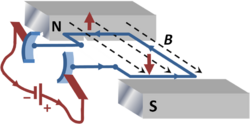Electric motor: Difference between revisions
imported>George clinkscales No edit summary |
imported>John R. Brews m (Paragraphing) |
||
| (15 intermediate revisions by 3 users not shown) | |||
| Line 1: | Line 1: | ||
{{subpages}} | {{subpages}} | ||
{{Image|Motor.PNG|right|250px|Electric motor using a current loop in a [[magnetic induction|magnetic flux]], labeled '''''B'''''}} | |||
An '''electric motor''' converts [[electrical energy]] into [[mechanical energy]]. The reverse process, that of converting mechanical energy into electrical energy, is accomplished by a [[Electrical generator|generator]] or dynamo. Most electric motors work by [[magnetism|electromagnetism]], but motors based on other electromechanical phenomena, such as [[electrostatic motor|electrostatic forces]] and the [[piezoelectric effect]] and thermal motors, also exist. The fundamental principle upon which electromagnetic motors are based is that there is a [[Lorenz force|mechanical force]] on any current-carrying wire contained within a magnetic field. The force is described by the [[magnetic field|Lorentz force law]] and is perpendicular to both the wire and the magnetic field. | |||
'' | The figure illustrates this principle for a single current loop as ''armature'' in a magnetic field provided by the north and south poles of a magnet. The Lorentz force at the left side is opposite in direction to that on the right, creating a [[torque]] twisting the loop. The contacts consist of a ''commutator'' electrically connected to two ''brushes'' that slide as the commutator turns. As the loop flips over, the current is kept circling in the correct sense to maintain the torque in the same direction for any position of the loop. In place of the permanent magnet, [[electromagnet]]s can be used.<ref name=discussion> | ||
Further discussion of parts and operation is found in {{cite book | |||
|title=Cyclopedia of engineering: a complete manual of steam and machine-shop practice | |||
|author=Louis Derr | |||
|url=http://books.google.com/books?id=tyzyAAAAMAAJ&pg=RA6-PA13 | |||
|pages=pp. 13 ''ff'' | |||
|chapter=Theory of dynamo-electric machinery |publisher=American technical society |year= 1902}} | |||
</ref> | |||
In a ''rotary'' motor, the rotating part (usually on the inside) is called the [[Rotor (electric)|rotor]], and the stationary part is called the [[stator]]. The rotor rotates because the wires and magnetic field are arranged so that a torque is developed about the rotor's axis. The motor contains electromagnets that are wound on a frame. Though this frame is often called the [[armature]], that term is often erroneously applied. Correctly, the armature is that part of the motor across which the input [[voltage]] is supplied. Depending upon the design of the machine, either the rotor or the stator can serve as the armature. | |||
Most magnetic motors are rotary, but [[linear motor]]s also exist. | |||
==Notes== | |||
<references/> | |||
Latest revision as of 12:34, 12 March 2011
- The content on this page originated on Wikipedia and is yet to be significantly improved. Contributors are invited to replace and add material to make this an original article.
An electric motor converts electrical energy into mechanical energy. The reverse process, that of converting mechanical energy into electrical energy, is accomplished by a generator or dynamo. Most electric motors work by electromagnetism, but motors based on other electromechanical phenomena, such as electrostatic forces and the piezoelectric effect and thermal motors, also exist. The fundamental principle upon which electromagnetic motors are based is that there is a mechanical force on any current-carrying wire contained within a magnetic field. The force is described by the Lorentz force law and is perpendicular to both the wire and the magnetic field.
The figure illustrates this principle for a single current loop as armature in a magnetic field provided by the north and south poles of a magnet. The Lorentz force at the left side is opposite in direction to that on the right, creating a torque twisting the loop. The contacts consist of a commutator electrically connected to two brushes that slide as the commutator turns. As the loop flips over, the current is kept circling in the correct sense to maintain the torque in the same direction for any position of the loop. In place of the permanent magnet, electromagnets can be used.[1]
In a rotary motor, the rotating part (usually on the inside) is called the rotor, and the stationary part is called the stator. The rotor rotates because the wires and magnetic field are arranged so that a torque is developed about the rotor's axis. The motor contains electromagnets that are wound on a frame. Though this frame is often called the armature, that term is often erroneously applied. Correctly, the armature is that part of the motor across which the input voltage is supplied. Depending upon the design of the machine, either the rotor or the stator can serve as the armature.
Most magnetic motors are rotary, but linear motors also exist.
Notes
- ↑ Further discussion of parts and operation is found in Louis Derr (1902). “Theory of dynamo-electric machinery”, Cyclopedia of engineering: a complete manual of steam and machine-shop practice. American technical society, pp. 13 ff.
